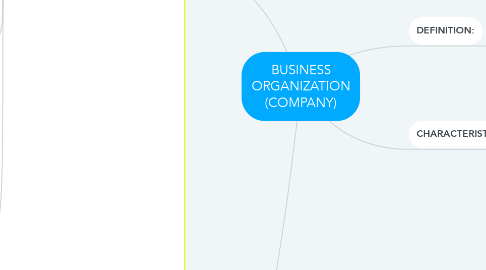
1. EFFECTS OF INCORPORATION
1.1. Separate legal entity
1.1.1. The principle is established by Salomon's case
1.2. Ability to sue and be sued in its own name
1.2.1. Section 21(1) - "can exercise all function including to sue and be sued"
1.2.2. Relevant case: Foss v Harbottle
1.2.2.1. - Fact: Shareholders sued directors for misappropriation of company's property.
1.2.2.2. - Held: Action cannot be maintained because it is for the company to sue, not members of the company.
1.3. Perpetual succession
1.3.1. Company does not die and is not affected by the death of all shareholders/controllers.
1.3.2. Section 20 (1) (b) - ".... co shall continue until it is removed from the register"
1.3.3. Relevant case: Re Noel Tedman Holding Pty Ltd
1.3.3.1. - Fact: There are only 2 shareholders (husband and wife). Both of them died in an accident and an infant child survived.
1.3.3.2. - Held: Company still existed and the shares of company were transferred to the beneficiary.
1.4. Ability to own properties
1.4.1. Can own lands and other immovable property in its own name.
1.4.2. Even if a person owns all the shares in a company, he does not own any of the company's properties.
1.4.3. Relevant case: Macaura v Northern Assurance Co Ltd
1.4.3.1. - Facts: Macaura sold all the timber on his estate to a company called Irish Canadian Sawmills Ltd.
1.4.3.2. - All the shares were owned by him or his nominees. He insured the timber in his own name.
1.4.3.3. - The timber was later destroyed in a fire, so Macaura put in a claim. However, it was rejected by the insurance company as he did not have insurable interest.
1.4.3.4. Held: Macaura and his company are two separate persons, so the property of the company is not a property of his.
1.5. Limited liability of shareholders
1.5.1. Company is liable for its own debt.
1.5.2. Holder of a fully paid shares cannot be made to contribute more to the company as members are to contribute the capital only once.
1.5.3. So, if a company is wound up, the most a shareholder will lose is the amount paid for his share(s).
1.5.4. Section 192 (1) - "a member shall not be liable for an obligation of a company by reason of only being a member of the co"
1.5.5. Relevant case: Re-application by Yee Yut Ee
1.5.5.1. - Held: Directors are not liable for debts of an incorporated company.
2. Lifting the veil of Incorporation
2.1. Statutory
2.1.1. Section 539 (3) and 540 (2) - Borrowing money when company has no ability to pay and fraudulent trading.
2.1.2. Section 186 (4) - Allotment of shares.
2.1.3. Section 123 (4) - Financial assistance to purchase shares.
2.1.4. Section 140 of Income Tax Act.
2.1.5. Section 540 (1) - Carrying on business to defraud creditor.
2.1.6. Section 46 of EPF Act.
2.1.7. Section 101B Employment Act.
2.2. Judicial
2.2.1. Use of co to evade legal obligations
2.2.2. Company employed as an agent/alter ego of its controllers.
2.2.3. Where court is asked to promote justice.
2.2.4. Group of companies.
